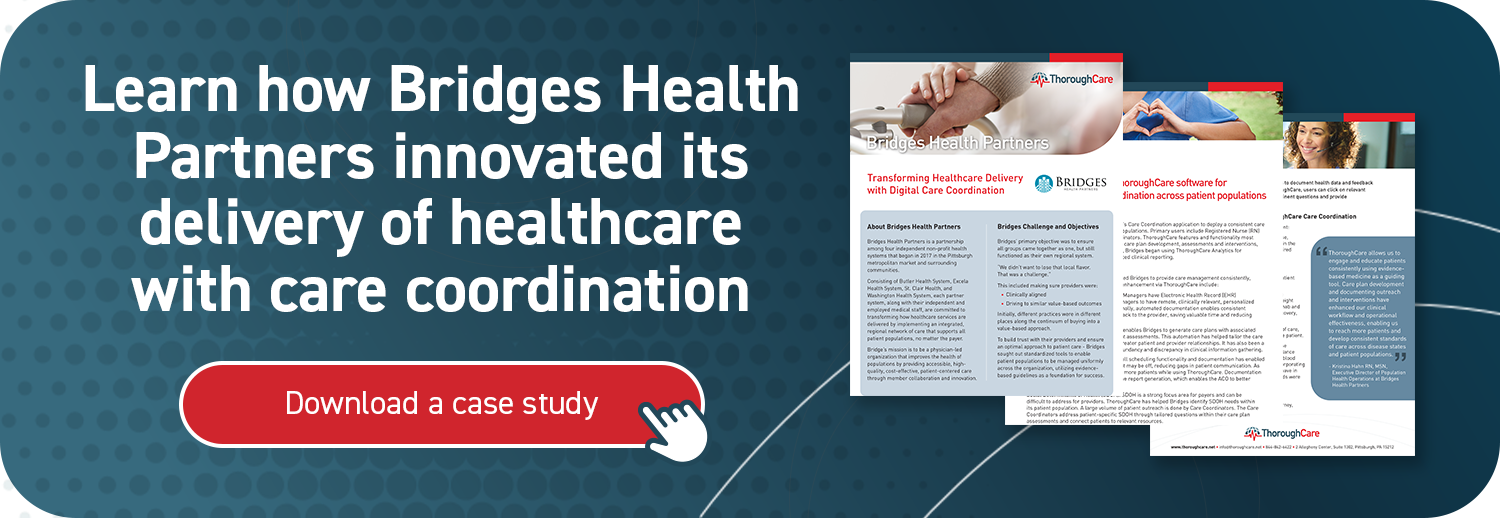Care Coordination | Social Determinants of Health
Addressing Social Determinants of Health With Care Coordination
Social determinants of health (SDOH), or the economic and environmental factors that influence the well-being of a population, exist beyond the walls of physician practices. Doctors cannot guard patients against these widespread, systemic influences.
They reach into nearly every aspect of our daily lives, whether they be the education we receive, the neighborhoods we live in or the food we have access to. Most people cannot change these conditions and must make do with their presence.
Unfortunately, the quality of life and the health of a population suffers as a result. According to the Kaiser Family Foundation, certain behaviors such as lifestyle choices and social and economic conditions “are the primary drivers of health outcomes” in the U.S. They may even lead to multi-generational impacts that will take time and complex solutions to unwind.
While healthcare has traditionally been reactive, with nearly 90% of medical spending accounted for by chronic diseases and mental health, the transition to value-based care has created a renewed focus on preventive health.
With a care coordination-based approach to medicine, providers can help patients recognize SDOH and connect them to appropriate resources to ease their effects. Care managers can serve as stewards to engage patients in mental health and help reduce barriers to other relevant resources through patient-centered relationships.
At ThoroughCare, we work with clinics and physician practices to help providers utilize software for digital care coordination. Our solutions have helped engage patients and connect them to wellness services that emphasize preventive health.
In this article, we’ll cover two ways digital care coordination can help provider organizations address SDOH and begin to manage patient populations.
What is Care Coordination?
Care coordination is the process of organizing various patient healthcare activities and communicating information between all concerned providers, patients, and caregivers. Its overall goal is to enable a more holistic, personalized approach to healthcare while reducing costs and negative outcomes through increased efficiency.
A patient-centered care plan is commonly used as an information hub within this process. It is created in collaboration with the patient to capture health needs and goals, and providers can refer to it as they help manage specific conditions across a continuum.
For addressing SDOH, care coordination can help providers assess patient risks, and eliminate barriers to support. Below, we’ll review both of these applications of care coordination for SDOH.
Utilize Risk Assessments to Address Behavioral Health Conditions
Behavioral health conditions affect nearly 53 million people in the U.S, and SDOH are very likely to play a role in their development.
For instance, people living in high poverty are more likely to experience negative mental health outcomes, according to the National Alliance on Mental Health. Children are especially vulnerable in these circumstances. This kind of childhood development can lead to reduced education quality and employment, which can lead to additional challenges and threats.
That’s not to say that adults don’t struggle.
Nearly 20% of adults aged 55 and over live with a behavioral health issue, according to the Centers for Disease Control and Prevention (CDC). Older generations are also more prone to stigmatizing mental healthcare. Because of this, seniors often fail to seek help, according to the Erie County Anti-Stigma Coalition.
A care management approach, like Behavioral Health Integration (BHI), can help address mental health concerns within this population. Medicare beneficiaries can utilize this service to connect with mental health resources, as well as use it to manage behavioral and chronic conditions together.
Risk assessments, such as PHQ-9 (Depression), GAD-7 (Anxiety), CAGE (Alcohol), DAST-10 (Substance Abuse), and MDQ (Mood Disorders), can help care managers and providers unearth contributing factors to patients’ mental health conditions. These evaluations are required when someone enrolls in a BHI program.
These tools can help engage patients in these sometimes-uncomfortable subjects and inform interventions that specifically speak to their goals. In these conversations, care teams may find opportunities to discuss how SDOH can influence certain symptoms or coping mechanisms.
With BHI, patients who have never previously addressed their mental health may find a way to start to improve this part of their life.
Reduce Patient Engagement Barriers with Digital Tools
Approximately 57 million Americans live in rural communities where care access can be challenging. Travel distances are commonly the most significant barrier, with many facilities being located far from where people live. This is according to a study published by the University of Minnesota School of Public Health.
This disconnect can fuel fairly preventable missteps, such as medication nonadherence.
If patients are disengaged from their care, they’re more likely to ignore a provider’s recommendations regarding the medication they’ve been prescribed. This habit affects between 40 to 50% of patients who receive prescriptions for chronic diseases.
This can result in about $100 billion in medical costs annually.
To improve patient engagement, some providers have turned to digital tools, such as care coordination software or mobile telehealth applications, to surmount physical distances.
With care coordination software, care managers can proactively establish and nurture relationships with patients, utilizing various functionality to personalize interactions. This can most effectively be accomplished by creating and continually developing patient-specific care plans.
“When care managers reach out to members with specific and appropriate solutions to problems they may have been struggling with for a long time, the members likely feel a combination of relief and gratitude,” Virginia Gurley, MD, MPH, writes for Managed Healthcare Executive.
Bridges Health Partners, one of our accountable care organization (ACO) clients, has utilized care planning to address SDOH directly with its patients.
The ACO’s on-staff care managers regularly use each individual’s care plan as a conversation guide. Bridges has noted that tailored questions within care plan assessments have helped connect patients to relevant resources, as well as reduce redundancy in clinical information gathering.
With these benefits, Bridges has reported stronger patient/provider relationships, leading to higher satisfaction, as well as greater overall engagement rates across its population.
Implementing Value-Based Care Coordination
Care coordination can enhance efforts in addressing SDOH. It can play an important role as part of a more holistic approach. By engaging patients and identifying opportunities for assistance, care coordination can help curtail the negative influence of certain social factors.
But how do you implement care coordination at a programmatic level?
With specific care management programs, such as Chronic Care Management (CCM), Remote Patient Monitoring (RPM), or Transitional Care Management (TCM), it’s possible to improve patient health outcomes while continually addressing patient lifestyle and disengagement.
For starters, learn how CCM can help your practice make care coordination actionable.
Additionally, digital software solutions are available to help your practice embrace integrated, coordinated care. At ThoroughCare, we’ve designed our care coordination software for easy clinical use with an intuitive interface that allows you and your team to engage patients through multiple care management and wellness programs.




